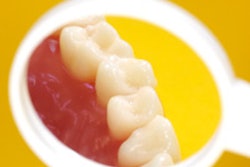
What if stem cells from extracted teeth could be used to save someone's vision after a terrible injury that caused them to lose their sight? That provocative premise fueled research from the U.K. that is a promising first step in the use of dental pulp stem cells.
As stem cell therapies move from theory to practice, researchers are investigating the use of different kinds of stem cells, including stem cells from dental pulp. Now, researchers at the University of Birmingham have found that dental pulp stem cells can protect retinal ganglion cells from death following an injury and also promote regeneration of the ganglion cells' axons along the optic nerve. Their research was reported in the journal Neural Regeneration Research (July 7, 2014).
Retinal ganglion cell loss is the leading cause of blindness. This loss can come from a traumatic injury or degenerative diseases such as glaucoma. Neurotrophic factors, which travel along the axon of a neuron to a cell body, act as survival signals. Following an injury, however, this supply is lost and the ganglion cells die. Hence, the concept is to supplement the injured ganglion cells with an alternative source of neurotrophic factors to protect them from death.
In the study, the researchers confirmed that dental stem cells naturally express multiple neurotrophic factors that can supplement the lost supply and protect retinal ganglion cells from death, as well as promote regeneration of their axons.
“Cell therapy is a promising treatment option as it provides a potentially limitless source of multiple growth factors for injured neurons.”
Researchers led by Ben Mead, a doctoral student at the University of Birmingham, noted that the use of dental pulp stem cells for neural protection and regeneration in the eye is a relatively new development in the field of neuroregenerative medicine. These stem cells are of particular interest as they are neural crest-derived cells that can be isolated from exfoliated or extracted adult teeth, making them an easily accessible stem cell from patients of all ages, according to previous research. These previous results led authors of the current study to wonder if dental pulp stem cells are better suited to treat central nervous system injuries than other mesenchymal stem cell sources because of their neural crest origin and neural characteristics.
"Cell therapy is a promising treatment option as it provides a potentially limitless source of multiple growth factors for injured neurons," Mead stated in a press release. "For clinical application, comparisons with other stem cells as well as development of safe delivery mechanisms are to be investigated in the future."
In this study, the authors compared the neuroprotective and proregenerative properties of dental pulp stem cells with those of bone marrow-derived mesenchymal stem cells for an in vitro and an optic nerve crush model after intravitreal transplantation.
The in vitro results showed that dental pulp stem cells are more neuroprotective and neuritogenic than the mesenchymal stem cells derived from bone marrow. And for the optic nerve crush model, the researchers transplanted the dental stem cells into a rat vitreous body. They saw a 27% increase in the number of surviving retinal ganglion cells 21 days after optic nerve crush compared with the survival of the ganglion cells in untreated/dead cell transplanted animals. This survival rate was significantly greater than was seen after intravitreal bone marrow stem cell transplants, they noted. The bone marrow stem cell transplants had previously shown an 11% increase in the number of surviving ganglion cells 21 days after optic nerve crush.
Compared with the bone marrow stem cells, transplantation of the dental stem cells promoted more than twice the number of regenerating retina ganglion cell axons, which grew through the optic nerve and lesion scar, as well as over 1.2 mm into the distal optic nerve segment, the study authors reported. They also noted that, in yet unpublished data, the duplication of these in vitro experiments using human-derived stem cells have now yielded similar results.
The study findings show that dental pulp stem cells may be a more appropriate cell type than bone marrow-derived mesenchymal stem cells for retinal therapy, the researchers concluded.



















